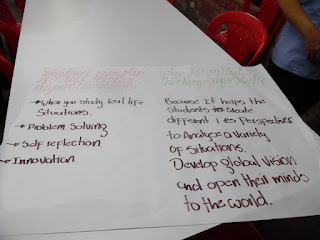On Friday, our group spent the morning at CUN university and the afternoon speaking to a panel of education experts about Colombia's education initiatives.
CUN University is a private university that targets students from public schools who would not necessarily think about college as an attainable goal. They make college accessible in a few ways.
First, CUN offers a mox of on-site, distance, weekend and e-learning opportunities. With these programs, they are reaching students in underserved areas of Colombia and offering classes that work with student schedules.
Second, CUN offers three different types of degrees. The first level of certification is tecnico. It requires that students complete a year and a half of college and at leave 500 hours of project-based work that is tied to their area of focus. Technological training is the second step and provides students with a deeper understanding of their field of study with an additional 500 hours of project-based or internship practice. The final level is he professional level which often takes 5 years to complete. The purpose of this structure is for students to have the flexibility to return to college and enhance their skills while building off of a solid base.
CUN is also partnering with high schools to give students access to advanced classes and help them with the college application process. The ministry of education is also offering scholarships called pilo pago to students who receive a 380 or above on the standardized 11th grade exam.
CUN is working to improve the quality of the education they provide to students and is going through an accreditation process. During our panel discussion with some of the professors it seemed that the school was making genuine efforts to make higher education a priority for its students.
In the afternoon we met with an incredible panel of women who are teachers, members of the ministry of education, and Fulbright scholars. They spoke with us about their efforts to make bilingual education a priority, how they were establishing paths for better teacher training, the data they used to measure growth and success and their emphasis on project-based learning. All panel members admitted that their progress was slow due to resources and bureaucracy but they didsee movement forward. In the last three years Colombia has increased its numbers of exchange programs, has worked with the Fulbright program to place English-speaking assistant teachers into custody ilombian classrooms, will be distributing textbooks to schools for the first time and has distributed curriculum for teachers to use and modify in their English classrooms.
 |
| Our wonderful panel of teachers and educators |
From an outsiders perspective, I met a lot of people who believe in the power of education and are working tirelessly to engage students, teachers and parents in this process.
 |
| At CUN |
 |
Students at CUN put on a great show for us with salsa dancing and live music
 |




















































